The Legacy of a Niagara Frontier's Polish Muralist

Father Justin and the Rosary Hour, 1967. Sgraffito.
Lobby, Chapel, St. Francis Conventual Residence, Athol Springs, NY
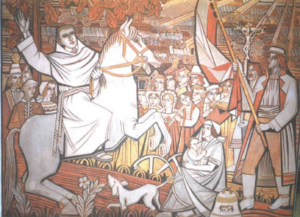
Father Moczygeba Welcoming Polish Immigrants to Texas, 1967. Sgraffito.
Lobby, the Chapel, St.
Francis Conventual Residence, Athol Springs, NY
It is Christmas Eve 1854. In front, Fr. Leopold Moczygeba, a Franciscan Conventual, is on horseback, restraining his rearing charger. Flanking him and behind him are the inhabitants of two villages of Silesia, whence he also hailed, who have come as immigrants to the United States, to the state of Texas. He brought them here from the port in Galveston. Gathered under an oak, they are about to take part in the first Holy Mass - the Pasterka - in the new land. In gratitude to Our Lady of Czestochowa for her care and request for continuing aid, the newcomers called their settlement in Texas, Panna Maria. In the distance are wagons covered with canvas, characteristic of American pioneers going west to settle new, primeval lands. The artist has shown the settlers in various folk costumes, to indicate later immigrations from all parts of Poland. One of the mothers presses her infant to her breast, the first American, born during the Pasterka. The artist did not forget to commemorate the symbols of the treasures they brought with them from the old country: these are the procession cross from the church, the Gospel, the church bell, the Polish flag, and a plow.
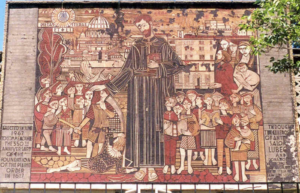
St. Joseph Calasanctius, 1973. Sgraffito, 18×12 ft.
The Graycliff Estate, Derby, NY
Calasanctius, who in 1597 opened Europe's first free school for poor children, was the founder of the Piarist Order. The sgraffito, which shows St. Calasanctius before a panoramic view of Rome surrounded by the children he sought to educate, was commissioned by the Piarist Fathers in 1967 to mark the 350th anniversary of the foundation of the Order. It is located on the side of a building the Fathers had built on the estate which they then owned. In 1998, the estate was bought by the Graycliff Conservancy, a grass-roots citizens organization which had as its goal the restoration of the principle builiding on the Estate, the summer house which famed architect Frank Lloyd Wright had built in 1924-27 for Mr. Darwin Martin, a Buffalo industrialist. The building to which the mural is attached, not being part of the original design and also not being sound, is scheduled ot be demolished in the summer of 2002. The Polish Arts Club of Buffalo waged a fundraising campaing the goal of which is to remove the mural from the building, transport it to the Church of the Assumption in Buffalo, and to place in a glassed in vestibule where, following restoration, it will be on view 24 hrs a day 365 days of the year. Fundraising was a success and the mural was moved to Buffalo State College.
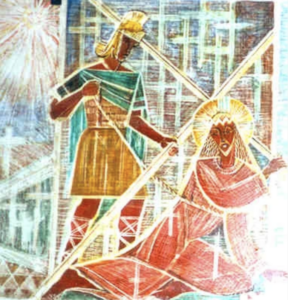
Stations of the Cross – IX and X, 1967. Scratched tempera.
Chapel, St. Francis Conventual Residence, Athol Springs, NY

Maid of the Mist Legend, 1973. Sgraffito, 20×9 ft.
The Slawinski Gallery and Studio Sgraffito, 125 Buffalo Avenue, Niagara Falls, NY
The legend of the Maid of the Mist, as expressed in the words "From the depths of a watery grave in the Niagara, she shall rise to meet the sun and a new life," inspired Prof. Slawinski's creation of this sgraffito mural. Having moved from Buffalo to Niagara Falls, at the invitation of the City's Mayor Lakey, Prof. Slawinski bought the house nearest to the Goat Island bridge opening there his Gallery and Studio Sgraffito. He erected the mural as a free standing structure in the garden adjoining the house, now the residence of his widow, where it continues to stand.
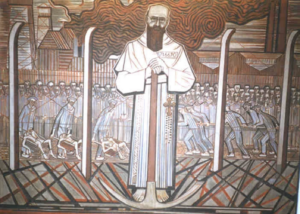
St. Maximillian Kolbe, 1967. Sgraffito.
Lobby, Chapel, St. Francis Conventual Residence, Athol Springs, NY
The figure of St. Maksymilian is shown with the Auschwitz Concentration Camp in the background. There, during the Second World War, the Nazis tried to dehumanize people. Fr. Maksymilian Kolbe courageously stood up in defense of the dignity of the maltreated prisoners when he gave his life for one of them, a man who was condemned to death through starvation in a bunker. High above his head there are two crowns, a choice offered him in his youth by the Immaculate Conception, the white one - signifying purity, and the red - martyrdom. Maksymilian already in childhood chose both crowns. It was in camp that he chose the red one. He stepped out from the ranks during a punitive roll-call, taking the place of the condemned man. The artist presents him not in the striped clothing of the camp, but in the Franciscan habit. His fellow prisoners are shown carrying out in wheelbarrows the bodies of their murdered colleagues. The guard towers and barbed wires charged with high voltage were supposed to take away all hope of rescue, and served to warn that the only escape to freedom was in the form of smoke rising from the furnaces of the crematory.
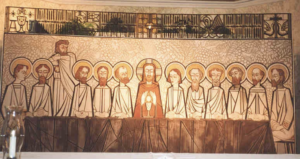
Last Supper, 1964. Sgraffito.
Chapel of Our Lady of the Sacred Heart, Stella Niagara, Lewiston, NY
The mural is located behind the altar in such a fashion that when the priest says mass he stand in for the figure of Christ.
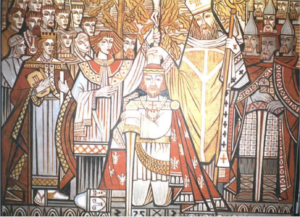
Baptism of Mieszko I, 1967. Sgraffito.
Lobby, Chapel, St. Francis Conventual Residence, Athol Springs, NY
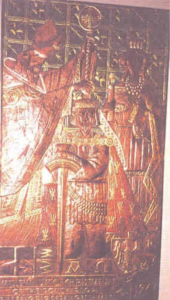
Baptism of Mieszko I, 1997. Hammered copper with gold.
Baptistery, St. Joseph Cathedral, Buffalo, NY
In 1996 Poland celebrated its millenium as a state, its recorded history commencing in 966 when Mieszko I, Poland's ruler accepted Christianity and with it the literate Latin civilization of which the Church was the guardian. Mieszko was a member of the ruling Piast family that had bagun organizing a Polish state a couple of hundred years earlier, but since the nation was illiterate and no written records were kept, that period belongs to Poland's prehistory.
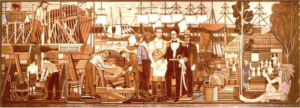
Commodore Perry at Black Rock, 1969. Sgraffito detail.
Lobby, West Hertel Middle School, Buffalo, NY
The mural, which Prof. Slawinski described as the first sgraffito-al fresco in North America, depicts the historical background of the school (far right of mural) in the village of Black Rock, now a part of Buffalo. During the War of 1812, shipbuilding, salt and a ferry service to Canada shaped the industrial environment of this pioneer school for three races. The life-size figures in the foreground are those of Commodore Oliver Hazard Perry, Shipbuilder Thomas Eckford (center), Perrys manservant, Hannibal and Eckfords Chief Clerk. Perry was in Black Rock in the spring of 1813 to acquire five of the nine warships with which he successfully engaged the British in the Battle of Lake Erie and thereby gave the United States control of the Lakes.
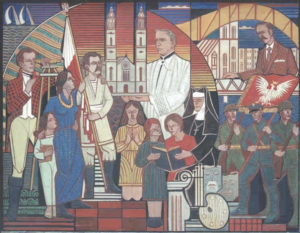
Buffalo Polonia, 1973. Sgraffito, panel 1.
Lobby, Erie County Medical Center, Buffalo, NY
Left hand portion of three panel mural created to mark the centenary of the foundation of St. Stanislaus Parish, the first organized Polish entity to be formed in Buffalo.
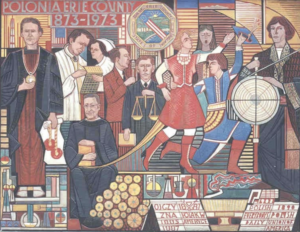
Buffalo Polonia, 1973. Sgraffito, panel 2.
Lobby, Erie County Medical Center, Buffalo, NY
Central portion of three panel mural created to mark the centenary of the foundation of St. Stanislaus Parish, the first organized Polish entity to be formed in Buffalo.
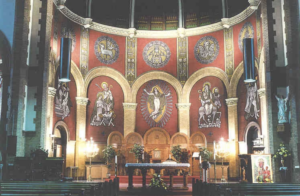
Scenes from the Life of the Blessed Virgin, 1963. Sgraffito.
Presbytery, Church of the Assumption, Buffalo, NY
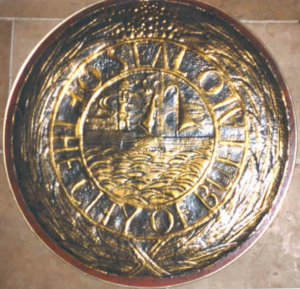
City of Buffalo Seal, 1969. Hammered copper.
Office of the Mayor, City Hall, Buffalo, NY
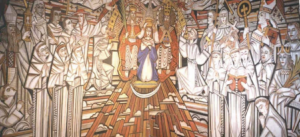
Altarpiece, 1967. Sgraffito.
The Chapel, St. Francis Conventual Residence, Athol Springs, NY
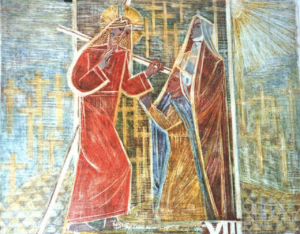
Stations of the Cross – VIII, 1967. Sgraffito.
The Chapel, St. Francis Conventual Residence, Athol Springs, NY
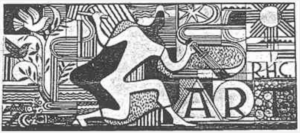
Józef Sławiński – the Artist as Creator, 1968. Sgraffito.
Daemen College, Amherst, NY
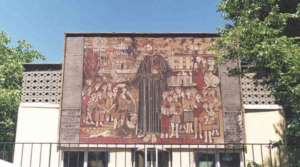
Saving Slawinski’s Sgraffito from Destruction
St. Calasanctius Mural at Graycliff - moved to Buffalo State College
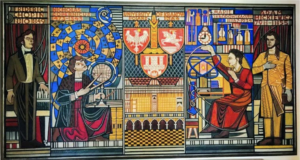
Polish Contributors to Humanity, 8×4 ft. Sgraffito.
Canisius College library, Polish contributors to humanity Chopin, Copernicus, Curie and Mickiewicz.
The work also depicts Poland's oldest institution for higher learning, Jagiellonian University also known as Krakow University.

Spirit of Buffalo, 52×40 in. Sgraffito.
The Buffalo and Erie County Library, Main Office on Lafayette Square
The major feature is the City Hall with the McKinley monument. Also prominent are a bison, the Skyway, ships on the waterways, grain elevators, factory smokestacks and office buildings, all tied together with sweeping lines indicating highways and the dynamics of a powerful city.
